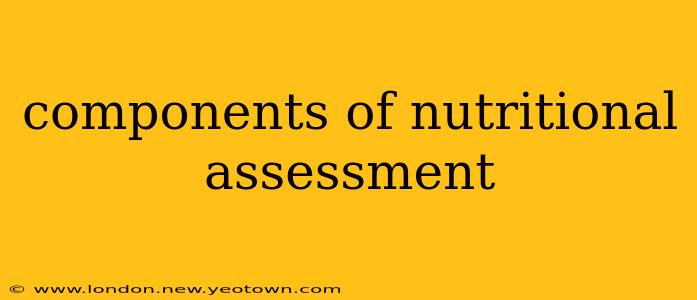Have you ever wondered how healthcare professionals determine if someone is getting the right nutrients? It's not just about asking what someone eats! Nutritional assessment is a complex process involving multiple components, each providing a piece of the puzzle to create a complete picture of an individual's nutritional status. This detailed guide explores the key components, answering common questions along the way.
What are the main components of a nutritional assessment?
A thorough nutritional assessment isn't a one-size-fits-all approach. Instead, it's a multifaceted process incorporating several key components:
1. Anthropometric Measurements: This involves taking physical measurements to assess body composition. Think of it like taking your vital signs, but for your body's structure. We're talking height, weight, body mass index (BMI), waist circumference, and sometimes even more specialized measurements like skinfold thickness. These numbers give a snapshot of your overall size and potential nutrient deficiencies. For instance, a low BMI might indicate inadequate calorie intake, while a high waist circumference could suggest increased risk of metabolic diseases.
2. Biochemical Data: This goes beyond simple measurements and delves into your body's chemistry. Blood tests are the workhorses here, revealing levels of key nutrients like vitamins, minerals, and proteins. Analyzing these levels allows healthcare professionals to detect deficiencies or excesses, revealing potential nutritional imbalances hidden beneath the surface. Blood tests can also help identify conditions impacting nutrient absorption or metabolism.
3. Clinical Examination: This is where a healthcare professional physically examines you, looking for visible signs of malnutrition. This could include things like dry skin, brittle hair, swollen limbs, or unusual bruising. A clinical examination provides important contextual clues alongside the other assessment components. It's a hands-on approach that complements the more quantitative data.
4. Dietary Assessment: This is arguably the most crucial aspect: understanding your eating habits. This might involve detailed dietary recalls (remembering everything you ate in the past 24 hours), food frequency questionnaires (how often you consume specific foods), or even food diaries (tracking your intake over several days). The goal is to get a clear picture of your typical dietary intake, identifying potential nutritional gaps or excesses.
5. Lifestyle Assessment: It's not just what you eat, but how you live. This component explores factors influencing nutritional status, including physical activity levels, smoking habits, alcohol consumption, and even socioeconomic status. These factors can significantly affect nutrient absorption, energy expenditure, and overall health. For example, a sedentary lifestyle coupled with a poor diet greatly increases the risk of obesity and related health problems.
What is the purpose of a nutritional assessment?
The ultimate purpose is to identify individuals at risk of malnutrition or those already experiencing nutritional deficiencies. Early detection allows for timely intervention, improving health outcomes and preventing complications. A thorough assessment can also provide valuable information in many circumstances, including weight management, disease prevention, and recovery from illness.
How is nutritional assessment used in healthcare?
Nutritional assessments are not just for individuals, they're critical tools in various healthcare settings:
- Hospitals: Identifying and managing malnutrition in hospitalized patients, optimizing recovery.
- Long-term care facilities: Ensuring adequate nutrition for elderly individuals who may have difficulties eating or managing their diets independently.
- Primary care: Assessing the nutritional risks of patients and promoting healthier eating habits.
- Public health: Understanding the nutritional status of populations to implement effective public health interventions.
What are the different methods of dietary assessment?
Several methods exist to assess dietary intake:
- 24-hour dietary recall: The individual recalls everything consumed in the past 24 hours.
- Food frequency questionnaire: The individual indicates how often they consume certain foods.
- Food record/diary: A detailed record of everything eaten over several days.
- Direct observation: Observing the individual's eating habits. (Less commonly used)
What are the limitations of nutritional assessment?
While extremely valuable, nutritional assessment isn't without limitations:
- Recall bias: Individuals might inaccurately recall their food intake.
- Time-consuming: Comprehensive assessments can be lengthy and resource-intensive.
- Cost: Certain biochemical tests can be expensive.
- Cultural influences: Dietary habits and preferences vary greatly across cultures, affecting interpretation.
By understanding and integrating all components, nutritional assessments empower healthcare professionals to provide personalized interventions that promote optimal health and well-being. It's a crucial step towards a healthier future for individuals and communities alike.

